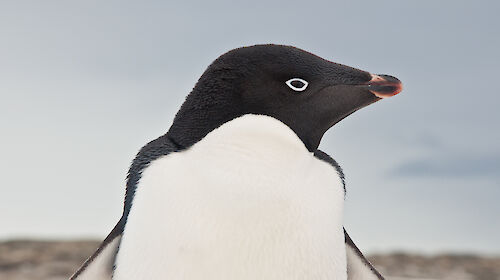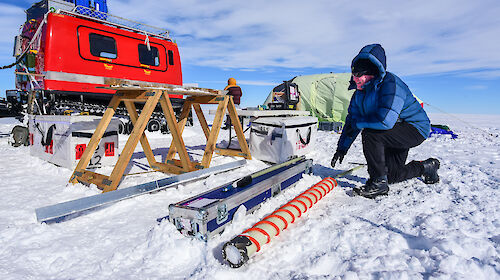Kim Kliska said Béchervaise Island is a hub for seabird life in East Antarctica.
“It’s a fairly flat, open island, with quite a few sub-colonies of Adélie penguins. We also have skuas, snow petrels and Wilson’s storm petrels breeding here as well,” she said.
“For all the seabirds we’re trying to understand how many are breeding for each species, and what their breeding success is.”
“We want to know how many eggs they lay, how many chicks hatch and how many then fledge at the end of the season, giving us a really good indication of the population numbers.”
Marcus Salton said the long-term monitoring program on Béchervaise Island is “unusual and unique” because it spans three decades.
“Thirty years is about the life span of a penguin, so we can start to look at things happening throughout that time, such as changes in breeding success and how that’s linked to changes in their environment,” he said.
Two specially-designed weighbridges at Béchervaise Island automatically weigh and identify penguins, recording data on foraging trip durations, time spent in the colony, and mass changes before and after feeding trips.
“Even when we’re not here we get a lot of information about individuals and over time we can look at how that’s changing in relation to breeding success,” Mr Salton said.
Penguins are an indicator species and this research on Adélie penguins is helping inform management of any krill fishing in the region.
“We can look at how much krill they’re actually feeding their chicks. From that we can get an estimate on how much they’re consuming, to ensure any krill fishing in the area leaves enough food for penguins too,” said Ms Kliska.
The biologists also maintain automatic monitoring cameras that take daily photos of the penguin colonies.
But nothing beats the high quality information gained from physically counting penguins on the ground.
“We also weigh the chicks, collect samples to inform us about their diet, genetics and environmental contaminants, and attach devices to track the bird’s foraging movements and behaviour,” said Ms Kliska
The seabird research program, which also extends to the broader Mawson region, has found the most recent number of Adélie penguins at all the islands within 50 kilometres to the east and west of the station is 120,000 breeding pairs.
“Here at Béchervaise Island we’ve got about 1500 breeding pairs of Adélie’s, so just a small proportion of the larger regional population,” Mr Salton said.







